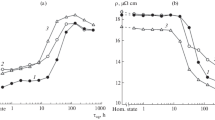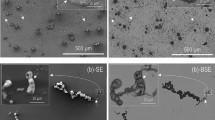Summary
In order to study the diffusion behaviour of caesium and silver in the technical high-temperature alloys Nimocast 713 LC, Nimonic 86, Inconel 625 and TZM, corresponding samples with polished surfaces were vacuum annealed between 700 and 1050° C for times between 170 and 5500 hr at Cs and Ag partial pressures of 10−6 mm Hg respectively. Post-exposure ion-microprobe mass analysis (IMMA) of a series of such samples, resulted in layer-stripping by sputtering and multielement depth profiles. The data were interpreted quantitatively with a physical model called the local thermodynamic equilibrium (LTE) model, and in some cases with the aid ofγ-spectroscopy with use of radioactive tracing materials. The results are discussed in terms of a comparison between the two approaches, and the quantitative concentration profiles are being used in a study of the diffusion behaviour in such systems. Good agreement with existing Cs diffusion data in pure nickel or molybdenum has been achieved.
Zusammenfassung
Wir untersuchten das Diffusionsverhalten von Cäsium und Silber in den technischen Hochtemperatur-Werkstoffen Nimocast 713 LC, Nimonic 86, Inconel 625 und TZM. Proben mit polierten Oberflächen wurden zwischen 700 und 1050° C im Vakuum während 170 bis 5500 h bei einem Csund Ag-Partialdruck von 10−6 Torr beladen. SIMS Nachfolgeexperimente mittels einer Ionenmikrosonde wurden an einer großen Anzahl solcher Proben ausgeführt. Dabei wurden die Multielement-Tiefenprofile in quantitative Konzentrations-Tiefenprofile transformiert unter Zuhilfenahme des LTE-(Local-Thermodynamic-Equilibrium)-Modelles von Anderson und Hinthorn. An einigen Proben wurden auchγ-spektroskopische Konzentrationsbestimmungen von radioaktivem, eindiffundiertem Cäsium mit den SIMS-Mes-sungen verglichen. Die quantitativen Konzentrations-Profile wurden mit einem einfachen Diffusionsmodell korreliert, wobei gute Übereinstimmung der Cs-Diffusionsparameter mit jenen in elementarem Nickel bzw. Molybdän gefunden wurde.
Similar content being viewed by others
References
A. Limon and W. B. Waeber, Atomkernenergie/Kerntechnik31, 87 (1981).
H. Liebl, J. Appl. Phys.38, 5277 (1967).
C. A. Andersen and J. R. Hinthorn, Analyt. Chemistry45, 1421 (1973).
T. Bolton, David Dunlop Observatory, Univ. of Totonto (private communication).
e. g. K. Hauffe, Reaktionen in und an festen Stoffen. Heidelberg: Springer-Verlag. 1966.
A. A. Korolev and L. V. Pavlinov, Fiz. Met. Metalloved.29, 1326 (1970).
N. Iniotakis, Kernforschungsanlage Jülich (private communication).
Author information
Authors and Affiliations
Additional information
Dedicated to Prof. Dr. Hanns Malissa on the occasion of his 60th birthday.
This work was performed as part of the development programme for a nuclear power station with a high-temperature reactor and high-power helium turbine, carried out in collaboration with the following firms: Brown, Bovery & Cie. AG, Hochtemperatur-Reaktorbau, Kernforschungsanlage Jülich, NUKEM GmbH, Swiss Federal Intsitute for Reactor Research and other Swiss partners.
Rights and permissions
About this article
Cite this article
Gras, D.J., Limon, A., Waeber, W.B. et al. Quantitative caesium and silver depth-profiles in hightemperature molybdenum- and nickel-base alloys. Mikrochim Acta 77, 85–95 (1982). https://doi.org/10.1007/BF01196759
Received:
Issue Date:
DOI: https://doi.org/10.1007/BF01196759




